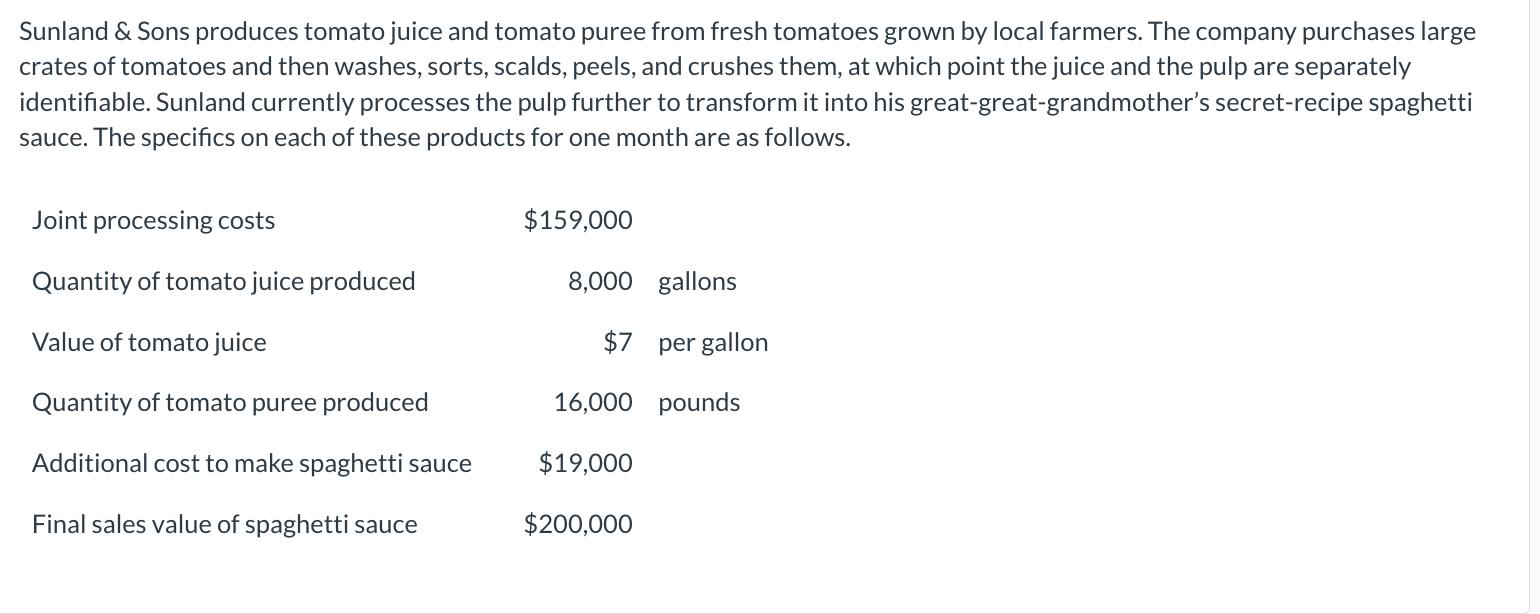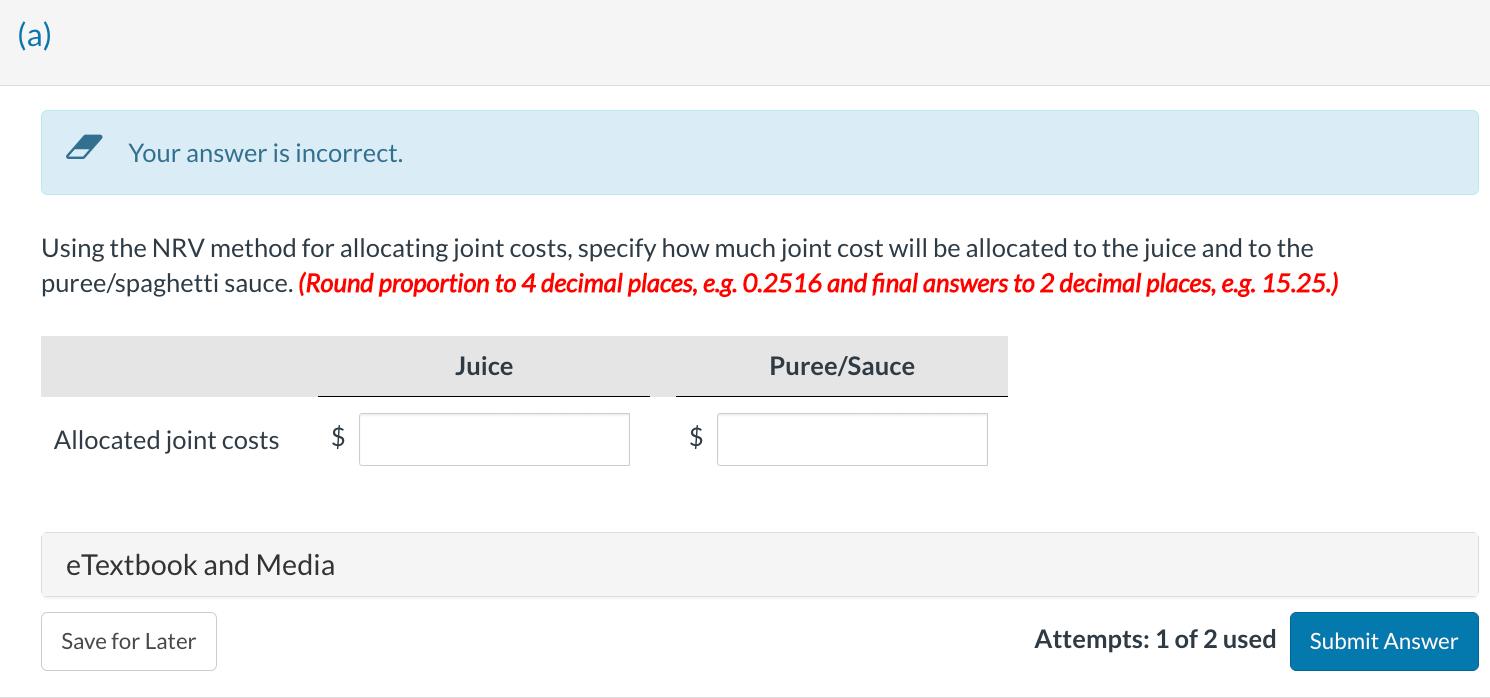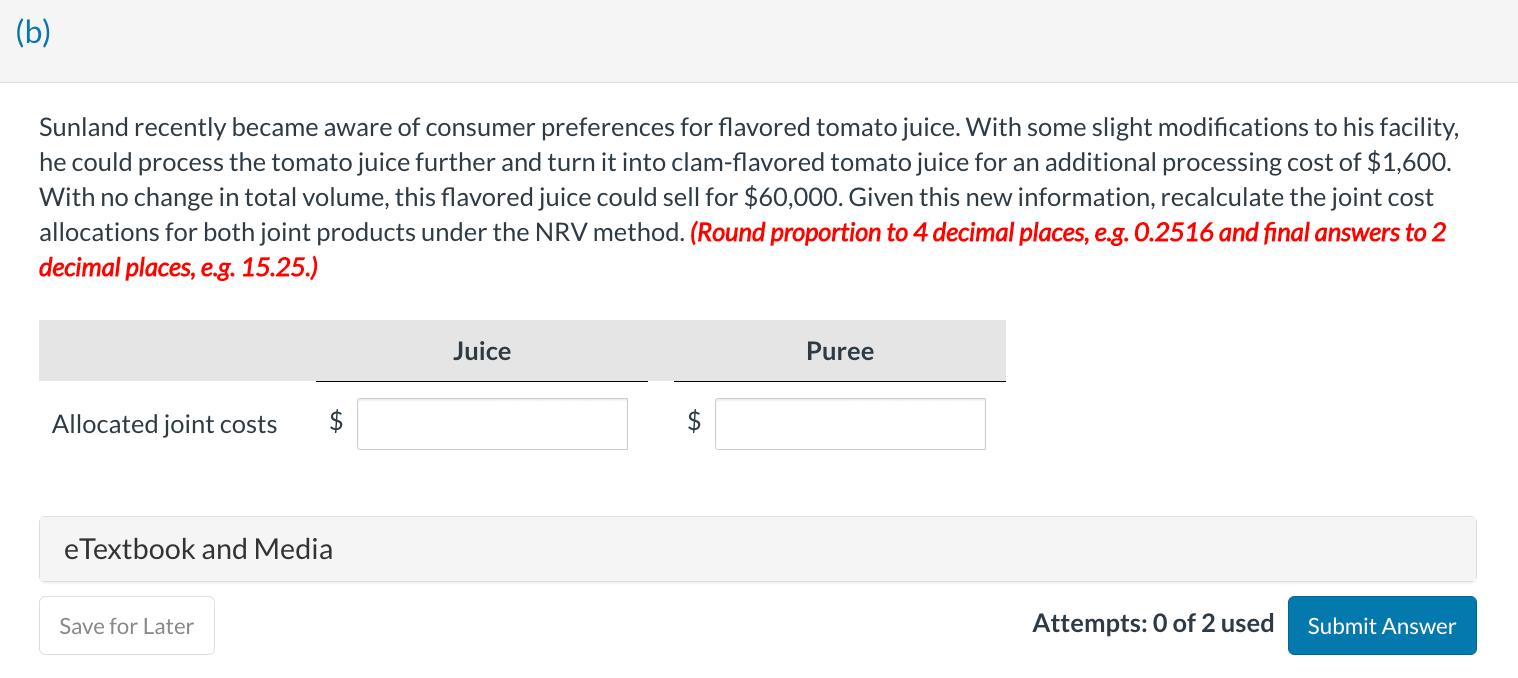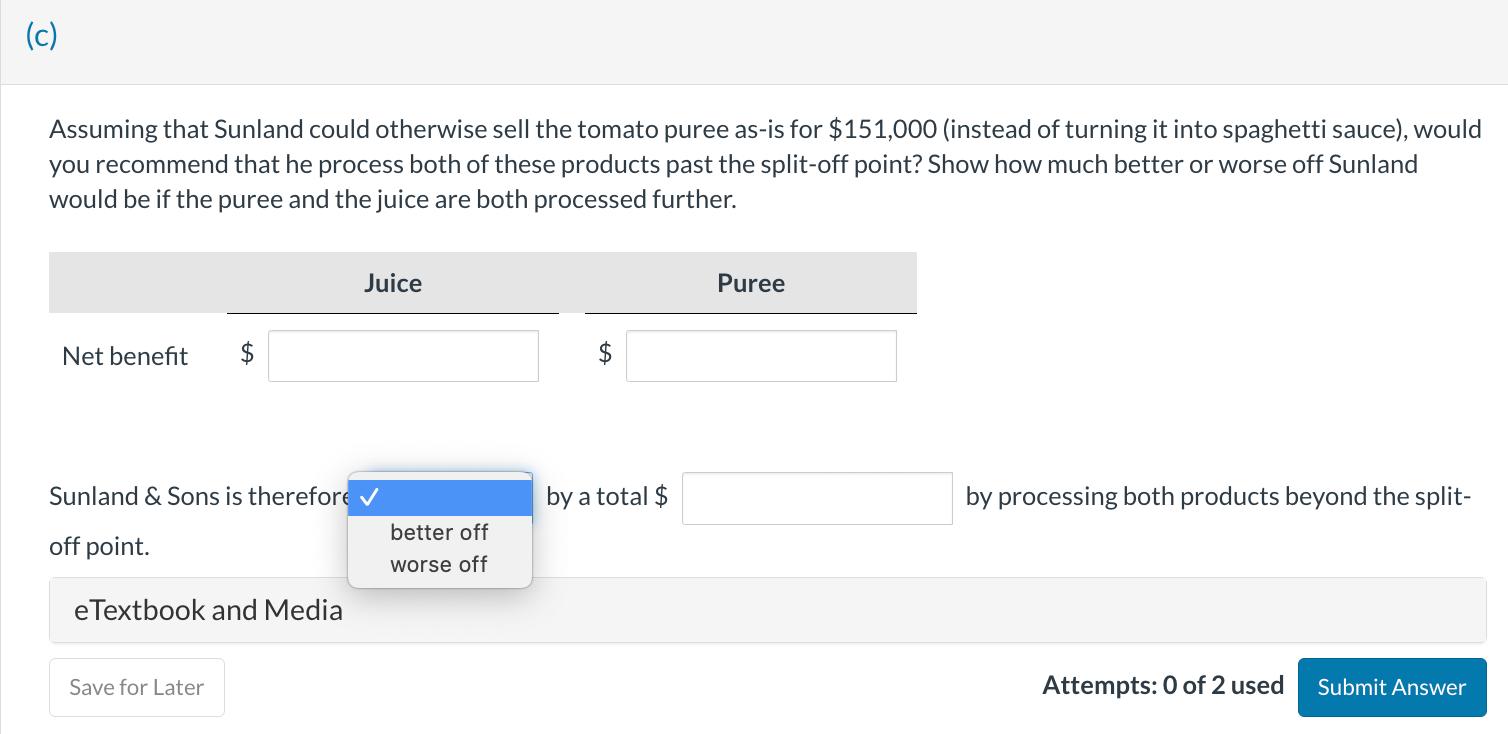Answered step by step
Verified Expert Solution
Question
1 Approved Answer
Sunland & Sons produces tomato juice and tomato puree from fresh tomatoes grown by local farmers. The company purchases large crates of tomatoes and
Sunland & Sons produces tomato juice and tomato puree from fresh tomatoes grown by local farmers. The company purchases large crates of tomatoes and then washes, sorts, scalds, peels, and crushes them, at which point the juice and the pulp are separately identifiable. Sunland currently processes the pulp further to transform it into his great-great-grandmother's secret-recipe spaghetti sauce. The specifics on each of these products for one month are as follows. Joint processing costs Quantity of tomato juice produced Value of tomato juice Quantity of tomato puree produced Additional cost to make spaghetti sauce Final sales value of spaghetti sauce $159,000 8,000 gallons $7 per gallon 16,000 pounds $19,000 $200,000 (a) Your answer is incorrect. Using the NRV method for allocating joint costs, specify how much joint cost will be allocated to the juice and to the puree/spaghetti sauce. (Round proportion to 4 decimal places, e.g. 0.2516 and final answers to 2 decimal places, e.g. 15.25.) Allocated joint costs eTextbook and Media Save for Later Juice Puree/Sauce Attempts: 1 of 2 used Submit Answer (b) Sunland recently became aware of consumer preferences for flavored tomato juice. With some slight modifications to his facility, he could process the tomato juice further and turn it into clam-flavored tomato juice for an additional processing cost of $1,600. With no change in total volume, this flavored juice could sell for $60,000. Given this new information, recalculate the joint cost allocations for both joint products under the NRV method. (Round proportion to 4 decimal places, e.g. 0.2516 and final answers to 2 decimal places, e.g. 15.25.) Allocated joint costs eTextbook and Media Save for Later Juice Puree Attempts: 0 of 2 used Submit Answer (c) Assuming that Sunland could otherwise sell the tomato puree as-is for $151,000 (instead of turning it into spaghetti sauce), would you recommend that he process both of these products past the split-off point? Show how much better or worse off Sunland would be if the puree and the juice are both processed further. Net benefit Sunland & Sons is therefore off point. eTextbook and Media Juice Save for Later better off worse off by a total $ Puree by processing both products beyond the split- Attempts: 0 of 2 used Submit Answer Sunland & Sons produces tomato juice and tomato puree from fresh tomatoes grown by local farmers. The company purchases large crates of tomatoes and then washes, sorts, scalds, peels, and crushes them, at which point the juice and the pulp are separately identifiable. Sunland currently processes the pulp further to transform it into his great-great-grandmother's secret-recipe spaghetti sauce. The specifics on each of these products for one month are as follows. Joint processing costs Quantity of tomato juice produced Value of tomato juice Quantity of tomato puree produced Additional cost to make spaghetti sauce Final sales value of spaghetti sauce $159,000 8,000 gallons $7 per gallon 16,000 pounds $19,000 $200,000 (a) Your answer is incorrect. Using the NRV method for allocating joint costs, specify how much joint cost will be allocated to the juice and to the puree/spaghetti sauce. (Round proportion to 4 decimal places, e.g. 0.2516 and final answers to 2 decimal places, e.g. 15.25.) Allocated joint costs eTextbook and Media Save for Later Juice Puree/Sauce Attempts: 1 of 2 used Submit Answer (b) Sunland recently became aware of consumer preferences for flavored tomato juice. With some slight modifications to his facility, he could process the tomato juice further and turn it into clam-flavored tomato juice for an additional processing cost of $1,600. With no change in total volume, this flavored juice could sell for $60,000. Given this new information, recalculate the joint cost allocations for both joint products under the NRV method. (Round proportion to 4 decimal places, e.g. 0.2516 and final answers to 2 decimal places, e.g. 15.25.) Allocated joint costs eTextbook and Media Save for Later Juice Puree Attempts: 0 of 2 used Submit Answer (c) Assuming that Sunland could otherwise sell the tomato puree as-is for $151,000 (instead of turning it into spaghetti sauce), would you recommend that he process both of these products past the split-off point? Show how much better or worse off Sunland would be if the puree and the juice are both processed further. Net benefit Sunland & Sons is therefore off point. eTextbook and Media Juice Save for Later better off worse off by a total $ Puree by processing both products beyond the split- Attempts: 0 of 2 used Submit Answer Sunland & Sons produces tomato juice and tomato puree from fresh tomatoes grown by local farmers. The company purchases large crates of tomatoes and then washes, sorts, scalds, peels, and crushes them, at which point the juice and the pulp are separately identifiable. Sunland currently processes the pulp further to transform it into his great-great-grandmother's secret-recipe spaghetti sauce. The specifics on each of these products for one month are as follows. Joint processing costs Quantity of tomato juice produced Value of tomato juice Quantity of tomato puree produced Additional cost to make spaghetti sauce Final sales value of spaghetti sauce $159,000 8,000 gallons $7 per gallon 16,000 pounds $19,000 $200,000 (a) Your answer is incorrect. Using the NRV method for allocating joint costs, specify how much joint cost will be allocated to the juice and to the puree/spaghetti sauce. (Round proportion to 4 decimal places, e.g. 0.2516 and final answers to 2 decimal places, e.g. 15.25.) Allocated joint costs eTextbook and Media Save for Later Juice Puree/Sauce Attempts: 1 of 2 used Submit Answer (b) Sunland recently became aware of consumer preferences for flavored tomato juice. With some slight modifications to his facility, he could process the tomato juice further and turn it into clam-flavored tomato juice for an additional processing cost of $1,600. With no change in total volume, this flavored juice could sell for $60,000. Given this new information, recalculate the joint cost allocations for both joint products under the NRV method. (Round proportion to 4 decimal places, e.g. 0.2516 and final answers to 2 decimal places, e.g. 15.25.) Allocated joint costs eTextbook and Media Save for Later Juice Puree Attempts: 0 of 2 used Submit Answer (c) Assuming that Sunland could otherwise sell the tomato puree as-is for $151,000 (instead of turning it into spaghetti sauce), would you recommend that he process both of these products past the split-off point? Show how much better or worse off Sunland would be if the puree and the juice are both processed further. Net benefit Sunland & Sons is therefore off point. eTextbook and Media Juice Save for Later better off worse off by a total $ Puree by processing both products beyond the split- Attempts: 0 of 2 used Submit Answer Sunland & Sons produces tomato juice and tomato puree from fresh tomatoes grown by local farmers. The company purchases large crates of tomatoes and then washes, sorts, scalds, peels, and crushes them, at which point the juice and the pulp are separately identifiable. Sunland currently processes the pulp further to transform it into his great-great-grandmother's secret-recipe spaghetti sauce. The specifics on each of these products for one month are as follows. Joint processing costs Quantity of tomato juice produced Value of tomato juice Quantity of tomato puree produced Additional cost to make spaghetti sauce Final sales value of spaghetti sauce $159,000 8,000 gallons $7 per gallon 16,000 pounds $19,000 $200,000 (a) Your answer is incorrect. Using the NRV method for allocating joint costs, specify how much joint cost will be allocated to the juice and to the puree/spaghetti sauce. (Round proportion to 4 decimal places, e.g. 0.2516 and final answers to 2 decimal places, e.g. 15.25.) Allocated joint costs eTextbook and Media Save for Later Juice Puree/Sauce Attempts: 1 of 2 used Submit Answer (b) Sunland recently became aware of consumer preferences for flavored tomato juice. With some slight modifications to his facility, he could process the tomato juice further and turn it into clam-flavored tomato juice for an additional processing cost of $1,600. With no change in total volume, this flavored juice could sell for $60,000. Given this new information, recalculate the joint cost allocations for both joint products under the NRV method. (Round proportion to 4 decimal places, e.g. 0.2516 and final answers to 2 decimal places, e.g. 15.25.) Allocated joint costs eTextbook and Media Save for Later Juice Puree Attempts: 0 of 2 used Submit Answer (c) Assuming that Sunland could otherwise sell the tomato puree as-is for $151,000 (instead of turning it into spaghetti sauce), would you recommend that he process both of these products past the split-off point? Show how much better or worse off Sunland would be if the puree and the juice are both processed further. Net benefit Sunland & Sons is therefore off point. eTextbook and Media Juice Save for Later better off worse off by a total $ Puree by processing both products beyond the split- Attempts: 0 of 2 used Submit Answer
Step by Step Solution
There are 3 Steps involved in it
Step: 1
a Using the Net Realizable Value NRV method the joint cost will be allocated based on the relative sales value of each product 1 Calculate the sales value proportion for tomato juice Tomato juice sale...
Get Instant Access to Expert-Tailored Solutions
See step-by-step solutions with expert insights and AI powered tools for academic success
Step: 2

Step: 3

Ace Your Homework with AI
Get the answers you need in no time with our AI-driven, step-by-step assistance
Get Started






